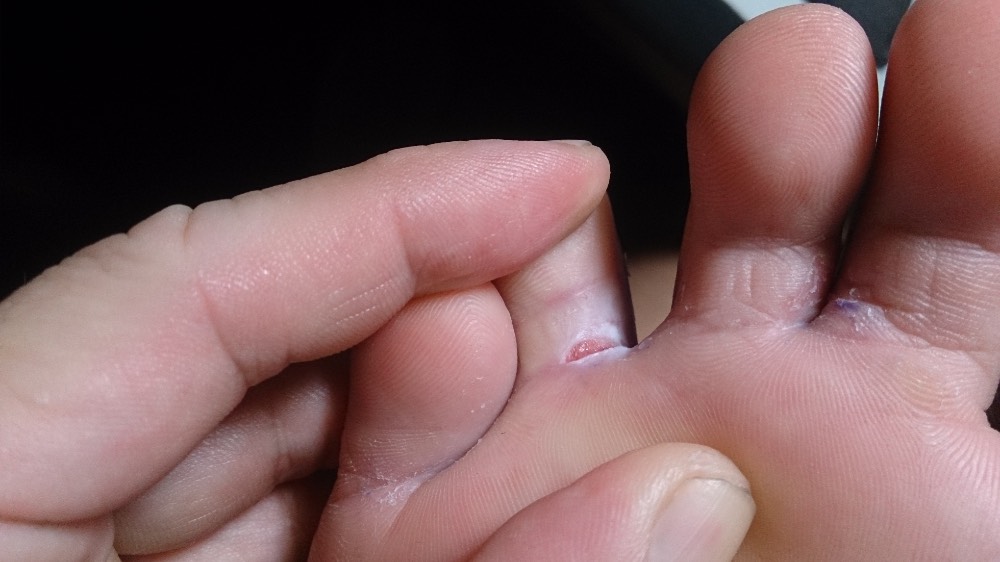Athlete’s foot is a common fungal infection, which usually appears between the toes. The affected skin may be red, itchy, dry, scaly, blistered or cracked. It is not usually serious but needs to be treated to stop it spreading to some other parts of the body or even other people.
Athlete’s Foot Signs and Symptoms
This type of ringworm usually appears on the bottom of the feet or affects the skin between the toes. Affected areas of skin could be:
- Red, dry, flaky and scaly
- Itchy
- White, cracked and soggy
- Covered in small blisters
- Sore
What Causes Athlete’s Foot?
This type of tinea fungal infection is caused by fungi growing and reproducing on the skin. These fungi thrive in warm, moist, and dark places as feet.
You are more likely to get this fungal infection if you:
- don’t keep the feet dry and clean
- walk around barefoot in areas where fungal infection can spread easily, as locker rooms, gyms, and communal showers
- wear shoes which cause the feet to get easily hot and sweaty
- you have a weak immune system
- share socks, shoes, and towels with other people
- have some other health conditions, as diabetes
Athlete’s foot can quickly spread to other people by coming into contact with contaminated objects or surfaces or touching infected skin.
Home Remedies for Athlete’s Foot
Proper hygiene and good skin care can help treat athlete’s foot. Treatment often involves pharmacy-bought creams, liquids, and sprays. However, this condition can be also effectively treated by using some simple home remedies.
Your Health Tubers, as supporters of conventional medicine which rely on approaches, proved to be effective and safe with carefully designed trials and research, offer you the following natural remedies for treating Athlete’s foot:
- Tea Tree Oil
It’s a great antiseptic that can alter the environment of the skin, making it harder for infection to do its work. Tea tree oil is well-known for its incredible soothing and healing properties for many skin ailments. Just mix equal amounts of tea tree oil and olive oil and rub the mixture into the affected place 2 times a day. The olive oil promotes the absorption of tea tree oil and softens the skin.
- Calendula Oil
Calendula is a well-known therapeutic herb. The antimicrobial and antiseptic action of the oil help speed up healing of skin infections, minor cuts, and wounds, and also benefit acne, bed sores, and insect bites. Calendulais applied to the skin to reduce inflammation and pain, and to treat poorly leg ulcers. Simply rub a few drops of calendula oil on the infected area, especially between the toes. It will soothe and heal your skin. Do this twice a day.
- Aloe Vera Gel
Aloe Vera gel is a popular home remedy for treating many skin infections and health problems. You can cut a leaf from aloe Vera plant and take the gel out of it. Rub the gel into the affected area 2-3 times a day. Alternatively, you can mix some aloe Vera gel with 3-4 drops of tea-tree oil and apply it on the infected skin. Use it twice a day for 2 months. It will soften your skin and eliminate the infection completely.
- Lavender Oil
Lavender has potent antifungal, antiseptic and anti-inflammatory properties. Research has proven that the essential oil of lavender can be useful for treating skin conditions, insomnia, anxiety, restlessness, and depression. Simply make a massage oil by placing 3-4 drops of lavender essential oil to a teaspoon of some carrier oil (you can use any vegetable oil). Rub into the affected area 1-2 times a day.
Important Tips
- Dry the feet thoroughly: after taking a shower or bath you need to dry your feet completely. You can even use a hair dryer, especially between the toes.
- Wear clean socks: you should wear clean socks made of natural fiber because they absorb moisture best. Avoid synthetics because they draw moisture away from the feet. Re-change your socks twice a day in case of tinea fungal infection to keep the feet sweat-free.
- Wear shoes made of leather or canvas: these materials will allow the feet to breathe. Plastic and forgo rubber hold moisture and can cause sweating easily.
- Avoid wearing the same shoes twice a day: it usually takes one day for shoes to dry out. In case your feet sweat easily, change the shoes two times a day.
- Wear shower shoes or slippers: do not walk barefoot, especially on certain places like gyms, locker rooms, around swimming pools, and health clubs. Always wear some ‘easy’ and comfortable shoes like slippers or shower shoes in case of a foot
- Use antifungal spray or powder for the shoes: you should dust the inside part of the shoes with some antifungal spray and powder. In order to destroy fungus microorganisms, spray disinfectant on a fabric and wipe out the inside parts of the shoes after taking them off.
- Soak your feet in ‘tea bath’: tea is a natural astringent that contains tannic acid, which works perfectly to dry out sweaty feet. Just steep 4-5 tea bags (you can use any tea) in a 33.8 oz./1 liter of boiling water for about 5 minutes. You can do this frequently as a part of the Athlete’s foot treatment.
- Use plain yogurt: yogurt contains live (good) bacteria that hold back the fungus. Dab some yogurt on the affected area, then let it dry. In the end, rinse off and dry your feet. It will give you an instant relief.
- Use baking soda: for soothing feet soak, place 2 teaspoons of baking soda (or salt) to 2-3 cups of warm water. Soak the feet inside for about 10 minutes. Do this frequently until your feet are wholly healed.
How to Prevent Athlete’s Foot?
You can decrease the risk of developing athlete’s foot by:
- Drying the feet gently but completely after washing them, especially in the areas between the toes;
- Wearing roomy shoes and cotton socks made of natural fabrics that can allow the feet to breathe;
- Wear a fresh pair of socks every day;
- Do not wear the same shoes every day – change them on 2-3 days. That will allow them to dry off between the uses;
- Do not walk around barefoot in public places;
- Not sharing shoes, socks, and towels with other people;
- Always use clean towels;
- Use talcum powder on the feet to avoid sweating, and
- Do not use moisturizer between the toes – it can help fungi multiply.
Conclusion:
Athlete’s foot (tinea pedis) and other fungal infections of the feet are contagious. They can easily spread by walking on contaminated floors and objects, or from person to person. This fungal infection can be treated with antifungal medicines, many of which are available OTC. However, you can treat fungal infections of the feet naturally by using home remedies. It is crucial to keep the feet dry by wearing breathable shoes and clean cotton socks to treat and prevent Athlete’s foot.
If you or your child develops a fungal infection of the feet, there is no need to stay off work/school. Just follow the advice above to treat the fungal infection and decrease the risk of spreading to others.



